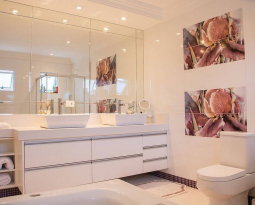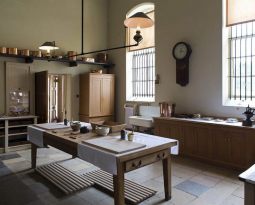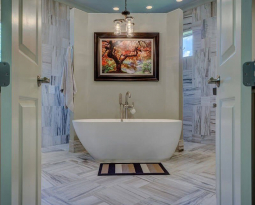A Marble Guy’s Maintenance Guide: How to Care for Granite Countertops
Watch any home-buying show and it’s difficult to find someone NOT on the hunt for granite countertops. They’re hugely popular and in demand, for good reason.
It’s hard as steel reputation and low maintenance personality makes it a great choice in any home… especially yours.
If granite is something you want to add to your home’s value and look, let’s discuss the best way to care for those countertops.
To Seal or Not to Seal? That Is the Question
There’s a big debate about whether granite countertops need sealant or not. And with tons of conflicting information out there, it’s easy to see why people are getting confused.
For the most part, granite will need to be sealed. It’s a natural stone that can be porous, which means it can easily stain if left untreated. But notice we said for the most part… not all granite falls into this category.
Some say the color of the granite has something to do with it. But to be sure, you can always do a spot test on your particular countertop.
This involves pouring a small puddle of water onto the stone. Time it to see how long it takes for the water to create a dark spot. If it darkens in 10 minutes or less, you need a sealer.
And if you’re unsure, it’s always best to test! Applying sealant when it’s not needed can cause a bigger issue. The sealant can puddle on the surface and dry, leaving a streaky, hazy mess!
How to Seal Granite
Sealing granite is a super simple process. Begin by cleaning your countertop to get rid of any dirt and debris. Then follow the manufacturer’s instructions to apply the sealant, as they may differ between products.
Make sure you apply the sealant to a completely dry stone. Then allow your countertop to dry, usually up to 24 hours.
Some sealants last for several years. Others will need reapplied every six months to a year. Make sure you get the product that will fit your needs and lifestyle.
If you’re not sure which sealant is best for your granite, be sure to ask one of our associates. Our trained staff is ready to answer any of your granite countertop questions.
How to Clean Your Granite Countertops
Daily cleaning of your countertops is very easy. All that’s required is a damp cloth and a few drops of dish soap. No chemicals or cleansers needed.
Dish soap can dull the appearance of your countertops over time, so be sure to rinse with clean water then dry with a soft cloth.
Keeping on top of any spills and messes will keep your countertops looking great and avoid any staining. Try not to rub any spills as this could cause the mess to spread and make any stains larger. Blotting it up is best.
To deep clean on a weekly basis, use a pH-neutral cleaner made only for granite countertops. Never ever use vinegar, bleach, or products that contain ammonia in them. Over time, those products will ruin the surface of your granite, so you have to be careful.
Monthly, it’s a good idea to apply a temporary granite polish to your countertop. It doesn’t give the surface its shine, it simply enhances it. And it acts like a car wax by improving cleaning.
The shine on your granite countertop comes from the factory. It’s shiny because it’s given a “polished” finish, which makes it part of the stone.
If your countertops ever look dull, it’s likely due to a film buildup. Or it has been physically or chemically damaged in some way. The shine does not go away on its own.
How to Deal with Granite Mishaps
If you come across stains in your granite, don’t panic. The trick is to first know what substance caused the stain to begin with. Once you know that, you can match up the right chemical ingredient to remove it when making your poultice.
The poultice is a powdery substance that will sit on top of the stain and absorb it up from the stone pores.
Chips or pits in the granite are often repaired using a color-matched epoxy. While this method works, it can also be quite noticeable. Using a clear acrylic is better and nearly invisible.
If you find a hairline crack in your granite, you usually don’t have to do anything. These types of cracks will not cause any more harm and won’t get worse over time. Any crack bigger, however, needs to be repaired by a professional.
Other Do’s and Don’ts
Here are some other tips and tricks to help keep your granite countertops looking like new.
Do: Use Coasters
While properly sealed granite helps protect it from staining, it’s best practice to use a coaster to avoid any moisture absorption from drinks or products.
Don’t: Leave Hot Items on the Countertop
It’s true that granite can withstand high temperatures, but exposure to extreme or constant temperature changes can damage the stone. Use hot pads. And never put a hot curling iron or another hot item on cold granite.
Do: Use Cutting Boards or Surfaces
This time it’s not so much about damaging your countertops but damaging your knives, razors, or other cutting utensils. Granite is hard and can be more durable than the steel in the knife you’re cutting with. But cutting on the granite can dull the blades.
Don’t: Stand or Sit on Your Granite Countertops
Even though granite is a hard surface, it’s not flexible. And unlike laminate countertops, granite isn’t backed by plywood. Applying too much weight in one spot may cause a crack.
Knowing How to Care for Granite Countertops Will Keep Them Beautiful for a Long Time to Come
You invested in the granite you love. And now you know how to care for granite countertops. All that’s left now is for you and your family to enjoy it for years to come.
Have questions about your granite countertop needs? Contact us today! We’d be happy to help and can give you an estimated quote!







